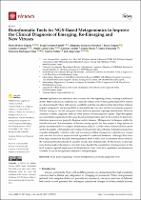| dc.contributor | Vall d'Hebron Barcelona Hospital Campus |
| dc.contributor.author | Colomer Castell, Sergi |
| dc.contributor.author | González Sánchez, Alejandra |
| dc.contributor.author | Campos Martinez, Carolina |
| dc.contributor.author | Garcia Cehic, Damir |
| dc.contributor.author | Piñana Moro, Maria |
| dc.contributor.author | Pumarola Suñé, Tomàs |
| dc.contributor.author | Rodríguez Frias, Francisco |
| dc.contributor.author | Quer Sivila, Josep |
| dc.contributor.author | Gregori Font, Josep |
| dc.contributor.author | Ibañez Lligoña, Marta |
| dc.contributor.author | Antón Pagarolas, Andrés |
| dc.contributor.author | Andrés Vergés, Cristina |
| dc.date.accessioned | 2023-03-21T09:16:13Z |
| dc.date.available | 2023-03-21T09:16:13Z |
| dc.date.issued | 2023-02-20 |
| dc.identifier.citation | Ibañez-Lligoña M, Colomer-Castell S, González-Sánchez A, Gregori J, Campos C, Garcia-Cehic D, et al. Bioinformatic Tools for NGS-Based Metagenomics to Improve the Clinical Diagnosis of Emerging, Re-Emerging and New Viruses. Viruses. 2023 Feb 20;15(2):587. |
| dc.identifier.issn | 1999-4915 |
| dc.identifier.uri | https://hdl.handle.net/11351/9210 |
| dc.description | Eines diagnòstiques; Metagenòmica; Virus |
| dc.description.sponsorship | This study was partially supported by Pla Estratègic de Recerca i Innovació en Salut (PERIS)—Direcció General de Recerca i Innovació en Salut (DGRIS), Catalan Health Ministry, Generalitat de Catalunya; the Spanish Network for Research in Infectious Diseases (REIPI RD16/0016/0003) from the European Regional Development Fund (ERDF); Centro para el Desarrollo Tecnológico Industrial (CDTI) from the Spanish Ministry of Economy and Business, grant number IDI-20200297; grants PI19/00301 and PI22/00258 from Instituto de Salud Carlos III, cofinanced by the European Regional Development Fund (ERDF); and Gilead’s biomedical research project GLD21/00006. S.C-C is a recipient of a predoctoral fellowship, FPU, from Ministerio de Universidades (FPU21/04150). |
| dc.language.iso | eng |
| dc.publisher | MDPI |
| dc.relation.ispartofseries | Viruses;15(2) |
| dc.rights | Attribution 4.0 International |
| dc.rights.uri | http://creativecommons.org/licenses/by/4.0/ |
| dc.source | Scientia |
| dc.subject | Genòmica |
| dc.subject | Genètica vírica |
| dc.subject | Epidèmies |
| dc.subject | Biologia computacional |
| dc.subject.mesh | Metagenomics |
| dc.subject.mesh | Computational Biology |
| dc.subject.mesh | Pandemics |
| dc.subject.mesh | Viruses |
| dc.title | Bioinformatic Tools for NGS-Based Metagenomics to Improve the Clinical Diagnosis of Emerging, Re-Emerging and New Viruses |
| dc.type | info:eu-repo/semantics/article |
| dc.identifier.doi | 10.3390/v15020587 |
| dc.subject.decs | metagenómica |
| dc.subject.decs | biología computacional |
| dc.subject.decs | pandemias |
| dc.subject.decs | virus |
| dc.relation.publishversion | https://doi.org/10.3390/v15020587 |
| dc.type.version | info:eu-repo/semantics/publishedVersion |
| dc.audience | Professionals |
| dc.contributor.organismes | Institut Català de la Salut |
| dc.contributor.authoraffiliation | [Ibañez-Lligoña M, Colomer-Castell S, Campos C, Quer J] Grup de Recerca de Malalties Hepàtiques, Vall d’Hebron Institut de Recerca (VHIR), Barcelona, Spain. Servei d’Hepatologia, Vall d’Hebron Hospital Universitari, Barcelona, Spain. Centro de Investigación Biomédica en Red de Enfermedades Hepáticas y Digestivas (CIBERehd), Instituto de Salud Carlos III, Madrid, Spain. Departament de Bioquímica i Biologia Molecular, Universitat Autònoma de Barcelona, Bellaterra, Spain. [González-Sánchez A, Andrés C, Piñana M] Servei de Microbiologia, Vall d’Hebron Hospital Universitari, Barcelona, Spain. Vall d’Hebron Institut de Recerca (VHIR), Barcelona, Spain. [Gregori J] Grup de Recerca de Malalties Hepàtiques, Vall d’Hebron Institut de Recerca (VHIR), Barcelona, Spain. Servei d’Hepatologia, Vall d’Hebron Hospital Universitari, Barcelona, Spain. [Garcia-Cehic D] Grup de Recerca de Malalties Hepàtiques, Vall d’Hebron Institut de Recerca (VHIR), Barcelona, Spain. Servei d’Hepatologia, Vall d’Hebron Hospital Universitari, Barcelona, Spain. Centro de Investigación Biomédica en Red de Enfermedades Hepáticas y Digestivas (CIBERehd), Instituto de Salud Carlos III, Madrid, Spain. [Pumarola T, Antón A] Servei de Microbiologia, Vall d’Hebron Hospital Universitari, Barcelona, Spain. Vall d’Hebron Institut de Recerca (VHIR), Barcelona, Spain. Departament de Microbiologia, Universitat Autònoma de Barcelona, Bellaterra, Spain. [Rodríguez-Frias F] Grup de Recerca de Malalties Hepàtiques, Vall d’Hebron Institut de Recerca (VHIR), Barcelona, Spain. Servei d’Hepatologia, Vall d’Hebron Hospital Universitari, Barcelona, Spain. Centro de Investigación Biomédica en Red de Enfermedades Hepáticas y Digestivas (CIBERehd), Instituto de Salud Carlos III, Madrid, Spain. Department of Basic Sciences, Universitat Internacional de Catalunya, Sant Cugat del Vallès, Barcelona, Spain |
| dc.identifier.pmid | 36851800 |
| dc.identifier.wos | 000940038600001 |
| dc.relation.projectid | info:eu-repo/grantAgreement/ES/PE2013-2016/RD16%2F0016%2F0003 |
| dc.relation.projectid | info:eu-repo/grantAgreement/ES/PE2017-2020/PI19%2F00301 |
| dc.rights.accessrights | info:eu-repo/semantics/openAccess |

 Àrea privada
Àrea privada Contacte
Contacte







